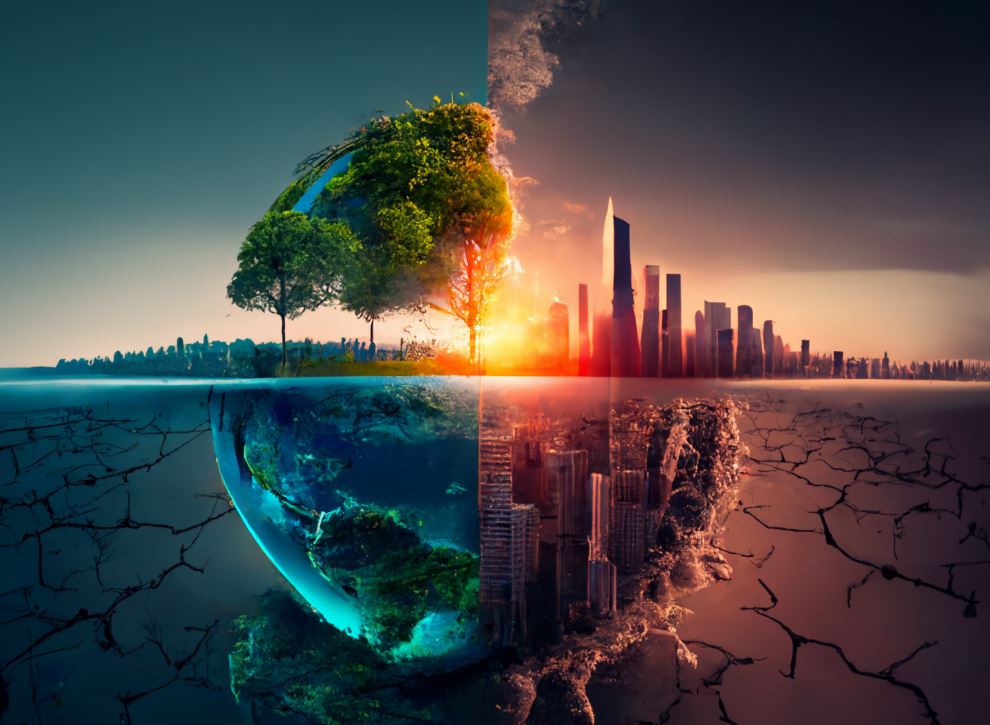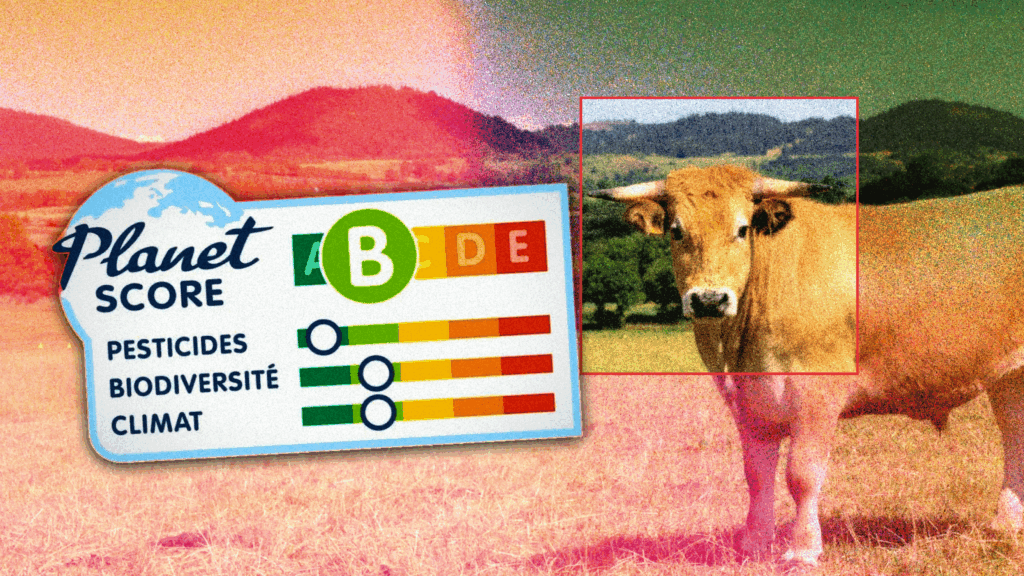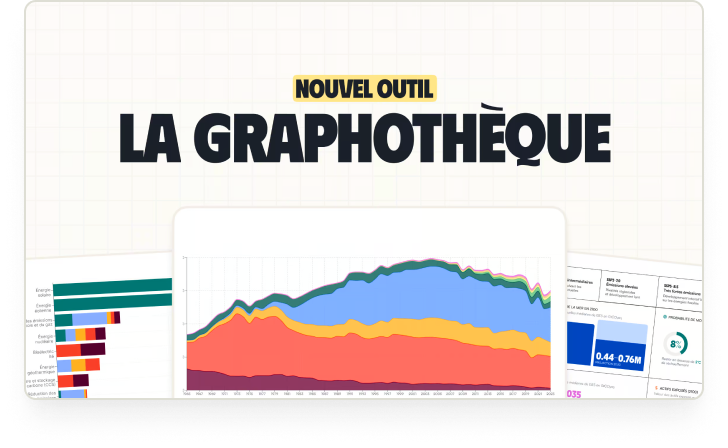The IPCC Synthesis Report (SYR) of the IPCC’s Sixth Assessment Report (AR6) is finally out! It summarises the state of knowledge on climate change, its widespread risks and impacts, and climate change mitigation and adaptation.
This report emphasizes the interdependence of climate, ecosystems and biodiversity, and human societies; the value of diverse forms of knowledge; and the close links between climate change adaptation, mitigation, and risk management.
It also highlights the losses and damages (see related article) that we are already experiencing and will continue to experience in the future, particularly affecting the most vulnerable people and ecosystems. This is very important, and we can only hope that the media and politics will be talking more about climate justice from now on.
For ease of reading, this article comes back on the key messages of this IPCC Synthesis Report, and then address them in FAQs to clarify some of the preconceived ideas that were widely circulated when the last report was released.
Foreword: before diving into the IPCC Synthesis Report
Before diving in, it is essential that you know what the IPCC is, how the authors of the report are selected, what the selection process is for scientific papers, who funds it, etc. If you know this already, that’s great, if not, read this article which summarises how it works in five minutes.
The IPCC Synthesis Report incorporates the main findings of the Sixth Assessment Report (AR6) based on the contributions of the three Working Groups and the three Special Reports. You can read a synthesis summary of each group below:
- Working Group I: the most up to date state of scientific knowledge and physical understanding of the climate
- Working Group II: focuses on the impacts, adaptation and vulnerability of human societies and ecosystems to climate change. Compared to previous versions, this report integrates more economics and social sciences, and clearly emphasises the important role of social justice in climate change adaptation.
- Working Group III: This report provides an up to date global assessment of progress and commitments on climate change mitigation. To put it more simply: what are the options for achieving carbon neutrality and stopping human-induced climate change?
It is important to note that the Synthesis Report does not contain any new scientific data, but simply summarises the main findings of the previous publications.
Key points of the IPCC Synthesis Report
The report is divided into three parts: Current Status and Trends, Future Climate Change, Risks and Long-Term Responses, and Responses in the Near-Term. The Synthesis Report is only 36 pages long, but it is very dense, and it will take you a couple of hours to read it through… and digest it.
Current Status and Trends
Observed warming and its causes
- Human activities, principally through emissions of greenhouse gases, have unequivocally caused global warming, with global surface temperature increasing of 1.1°C for the period 2011–2020, compared to the period 1850–1900.
- Global greenhouse gas emissions have continued to increase, with unequal historical and ongoing contributions arising from unsustainable energy use, land use and land-use change, lifestyles and patterns of consumption and production across regions, between and within countries, and among individuals.
- Approximately 3.3 to 3.6 billion people live in contexts that are highly vulnerable to climate change – people living in highly vulnerable areas are 15 times more likely to die from floods, droughts and storms between 2010 and 2020 than those living in areas with low vulnerability.
- Ecosystems are being damaged by rising temperatures, leading to species mass mortality events on land and in the oceans. Some ecosystems are approaching a point of no return, due to impacts such as retreating glaciers and the thawing of the Arctic permafrost.
- Climate change has reduced food security and affected security of access to water. Extreme heat events are increasing mortality rates and diseases.
- Rising temperatures, trauma from extreme events and loss of livelihoods and culture lead to mental health problems (A.2.5). Mental health is also mentioned 3 times in this report!
The figure below shows the changes observed (1900-2020) and projected (2021-2100) in temperature on the surface of the Earth (compared to 1850-1900), which are linked to changes in climate conditions and impacts. This illustrates how the climate has already changed and will change over the lifetime of three representative generations (born in 1950, 1980 and 2020).
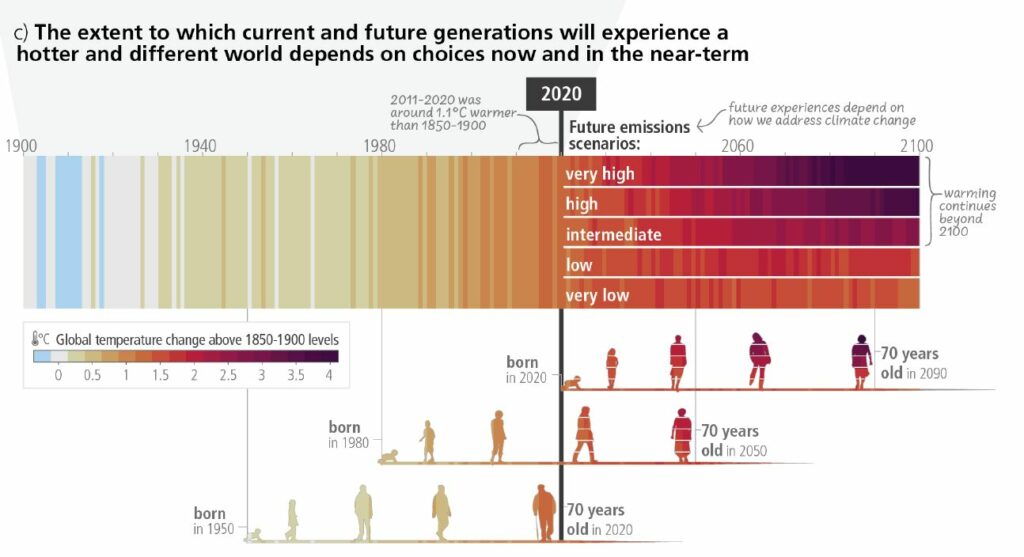
Current progress in adaptation, and gaps and challenges
- Progress in adaptation planning and implementation has progressed across all sectors and regions, with documented benefits and varying effectiveness. Despite progress, adaptation gaps exist across sectors and regions, and will continue to grow under current rates of implementation.
- Several adaptation limits have already been reached in some ecosystems and regions. Some sectors and regions are experiencing ‘maladaptation’.
Insufficient financial flows
- Current levels of climate finance are grossly inadequate and are still largely exceeded by fossil fuel finance flows. This point is an excellent reminder and directly contradicts the messages that fossil fuel companies such as TotalEnergies have communicated to the public, and which are mainly focused on its investments in renewables while, in fact, the majority of its investments are in fossil fuels.
- Current global financial flows for adaptation are insufficient and limit their implementation, particularly in developing countries (high confidence).
Future climate change, risks and long-term responses
- Global warming increasing to +1.5°C? Continued greenhouse gaz emissions will increase global warming, with the best estimate of reaching +1.5 in the near term, in the early 2030s.
- Deep, rapid and sustained reductions in greenhouse gaz emissions would lead to a discernible slowdown in global warming within about two decades. Let’s remind ourselves that this does not mean that there is “20 years of inertia”, but that the inertia is political. An article to read on this subject.
- Air quality: with rapid reductions in greenhouse gaz emissions emissions, we would have discernible changes in the composition of the atmosphere within a few years. One of the many co-benefits of acting now against climate change: breathing cleaner air!
- Every fractional increase in global warming will increase multiple and simultaneous risks (high confidence). Cumulative heat waves and droughts are expected to become more frequent, including simultaneous events at multiple sites.
Adaptation and its limits
Figures SPM.2 and SPM.4 below provide an excellent explanation of the risks of further warming and remind us that every fraction of a degree counts.
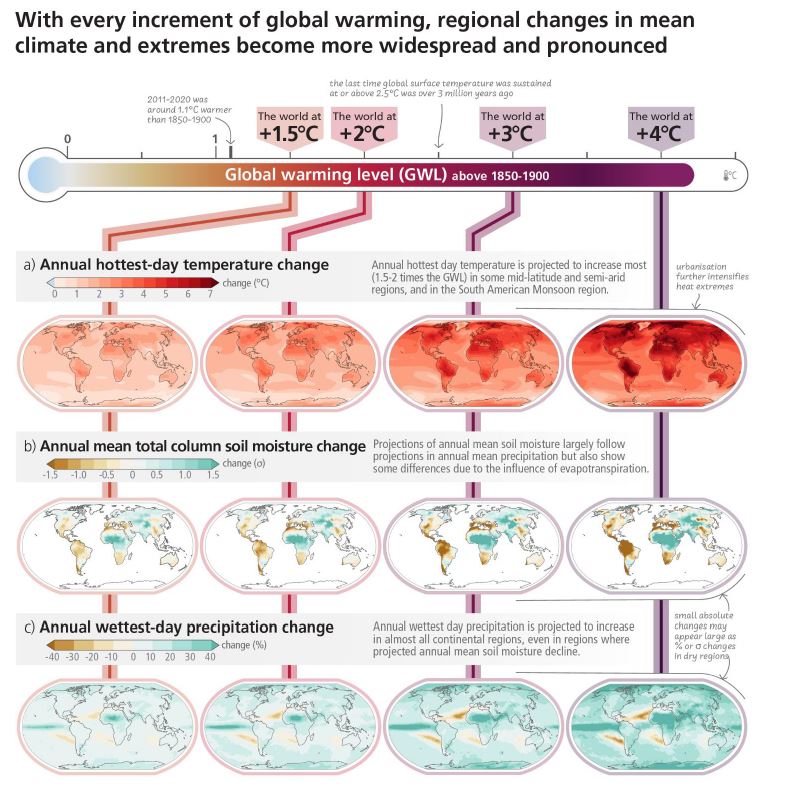
Figure SPM.4: Adaptation has its limits and, beyond a certain threshold of warming, the risks increase of having areas where high heat becomes lethal. We explained this in a dedicated article: Dying of heat: at what degree does the temperature become lethal?
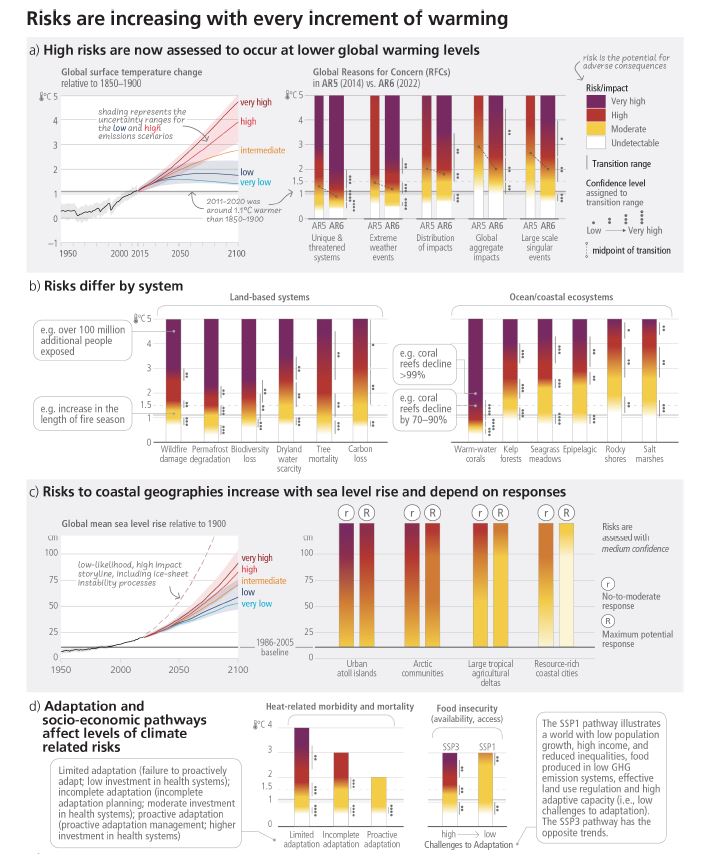
Section B.3 of the report also stresses that some future changes in the climate are unavoidable and/or irreversible, but that these can be limited by a deep, rapid and sustained global greenhouse gas emissions reduction.
Finally, and as in the Working Group III Report, the IPCC Synthesis Report (B.5) states that: projected CO2 emissions from existing fossil fuel infrastructure without additional abatement would exceed the remaining carbon budget for 1.5°C (>50%).
This is an extremely important point: without anticipated closure of some of the coal, gas and oil operations, we will exceed +1.5°C warming. No journalist has ever stressed this point to a member of the government in an interview, or to an executive at TotalEnergies or Engie.
NEWSLETTER
Chaque vendredi, recevez un condensé de la semaine, des infographies, nos recos culturelles et des exclusivités.
ALERTE
Une alerte dans votre boite mail, pour être mis au courant dès qu’un nouvel article est en ligne sur Bon Pote
Near-term responses: how to act?
The last part of the IPCC Synthesis Report deals with near-term action to climate change.
Urgent need for integrated near-term climate action
- Climate change is a threat to human well-being and the health of the planet (very high confidence). The window of opportunity to secure a liveable and sustainable future for all is rapidly narrowing.
- Deep, rapid and sustained mitigation and accelerated implementation of adaptation actions in this decade would reduce the projected losses and damages for humans and ecosystems (very high confidence). It would also provide many co-benefits, especially for air quality and health (high confidence).
- The current trajectory of emissions with the adopted policies leads us to global warming well above +2°C:
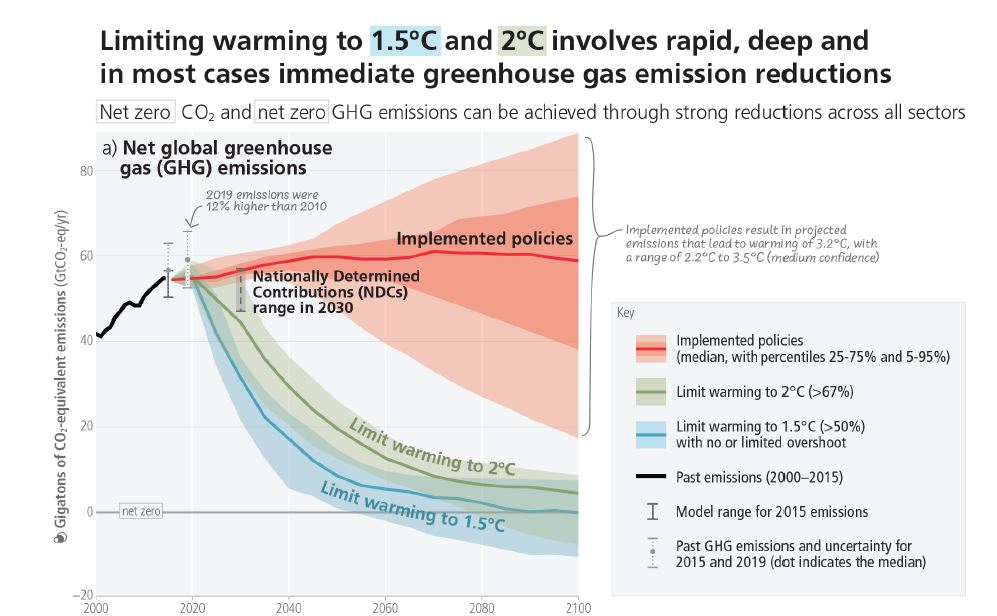
There are multiple opportunities for scaling up climate action, as highlighted in Figure SPM.7 below:
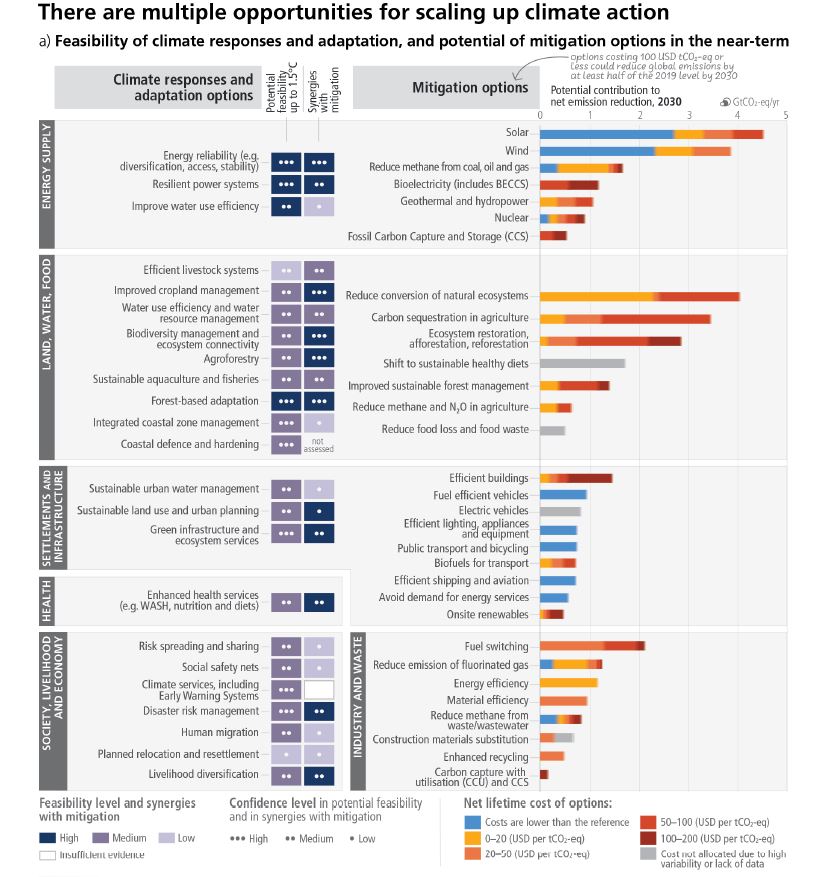
For the first time, sobriety is highlighted in a Synthesis Report as one of the solutions for achieving carbon neutrality. For some industries, the potential for reducing emissions varies between 40 and 70%!

Equity and inclusion!
The IPCC Synthesis Report highlights that: prioritising equity, climate justice, social justice, inclusion and just transition processes can enable adaptation and ambitious mitigation actions and climate resilient development. A concept that is too often ignored by politics.

FAQ
Is it too late? Do we only have 3 years left?
The answer is very simple: NO! It is not too late.
It is wrong to say that we are already doomed. Climate ‘doomism’ is one of the 12 discourses of climate inaction that we need to fight.
Of course, it is too late to prevent damage (social, environmental, etc.). But there is no point in exaggerating what science tells us about the climate (even if it sells…). Avoiding climate ‘doomism’ is key if we want to achieve our climate objectives. Let’s also remember two language elements that come up very (too) often and that must absolutely be avoided:
- There is no deadline. It is not in 2030 on the dot (or 2040) that the world will tip over into the apocalypse. Besides, having a precise date makes no sense in climate science, which is a science over time. Yes, it was better to act 20 or 30 years ago. But just because we haven’t acted by 2025 or even 2030 doesn’t mean that everything is over. The point is that the later we act, the more catastrophic it will be.
- If we fail to keep warming to +1.5°C, the next target is not +2.°C, but +1.51°C. The IPCC is very clear on this: every tonne emitted contributes to warming. If you don’t know which actions have the most impact on global warming, you can simulate your carbon footprint.
Are we going to exceed +1.5°C?
As with every publication of an IPCC report, questions arise about a global warming of +1.5°C. The Synthesis Report states that: based on the pledges made by Nation States to reduce their emissions (Nationally Determined Contributions or ‘NDCs’) in 2021, it looks “likely” that this temperature will be exceeded by the end of the century.

The IPCC Working Group I said that all SSP scenarios project a global warming of 1.5°C. The most ambitious emissions projection is that we will reach 1.5°C in the 2030s, then peak at 1.6°C, before falling back to 1.4°C by the end of the century. So there is no doubt that we will exceed 1.5°C.

Fossil fuels mentioned 8 times in the IPCC Synthesis Report
Fossil fuels are mentioned 8 times in the Synthesis Report, including twice in the footnotes.
It is noted only once in the boxes (the most visible elements in the report), including in the box B.5 that points out that keeping with the status quo of existing fossil fuel infrastructure means a 50% chance of exceeding the carbon budget for limiting global warming to 1.5°C.
It will be important to follow what happens at COP28. Let’s remember that the negotiators still haven’t included the words “gas” and “oil” in the text, even though everyone knows that we need to drastically limit their consumption now.
Is global warming 100% caused by human activities, or only partially?
On reading box A.1 “Human activities, principally through emissions of greenhouse gases, have unequivocally caused global warming”, we can immediately anticipate that climate sceptics and other “clever” people will come to remind you that, after all, “it’s not 100% man-made”.
Well, what was stated in Working Group I is again stated in point A.1.2 of this Synthesis Report. You can see it below: for a warming of +1.1°C, the warming is with a “best estimate” of +1.07°C. Of course, one has to take into account the uncertainties with aerosols etc. But evidently, solar cycles are not the culprits here.

Human activities have unequivocally caused global warming, mainly through greenhouse gas emissions.
Why an IPCC Synthesis Report if there is nothing new?
The report is expected to serve as a basis for the next UN climate summit, COP28, which will be hosted by the United Arab Emirates in Dubai from 30 November 2023.
It is probably also an opportunity for citizens who have not had the opportunity to read the previous reports to do so with a “summarised” version. Let’s not forget that the whole 6th Assessment Report is thousands of pages long, refers to thousands of scientific studies and that no human could claim to have read the report, as well as all the sources mentioned.
A huge thank you to the volunteer scientists, the IPCC members, and to all the people who are fighting to keep the world liveable for as many people as possible.
You cannot imagine the euphoria that the ipcc synthesis report is pre-approved in the longest plenary ever!
— Diana Urge-Vorsatz (@DianaUrge) March 19, 2023
After 46 hours with a total of 3 hours of sleep… pic.twitter.com/O54StLiXin
After reading the IPCC synthesis report, how to take action?
Beyond the content of the report, it is vital that it is relayed by the media. Previous reports have been overshadowed by other issues (Messi’s arrival at PSG, the war in Ukraine, etc.) and media coverage has never been on a par with the climate emergency. Let’s hope that’s the case this time.. But we can talk about this report all year long!
In addition, here are some tips and articles to read:
- Calculate your own carbon footprint: by far the most effective thing to do. Knowing where to act personally and asking for structural changes to act collectively.
- 10 simple actions to go green.
- Why stopping flying should no longer be a debate.
- Follow Bon Pote on social networks, where climate activity will be sustained all year round.

